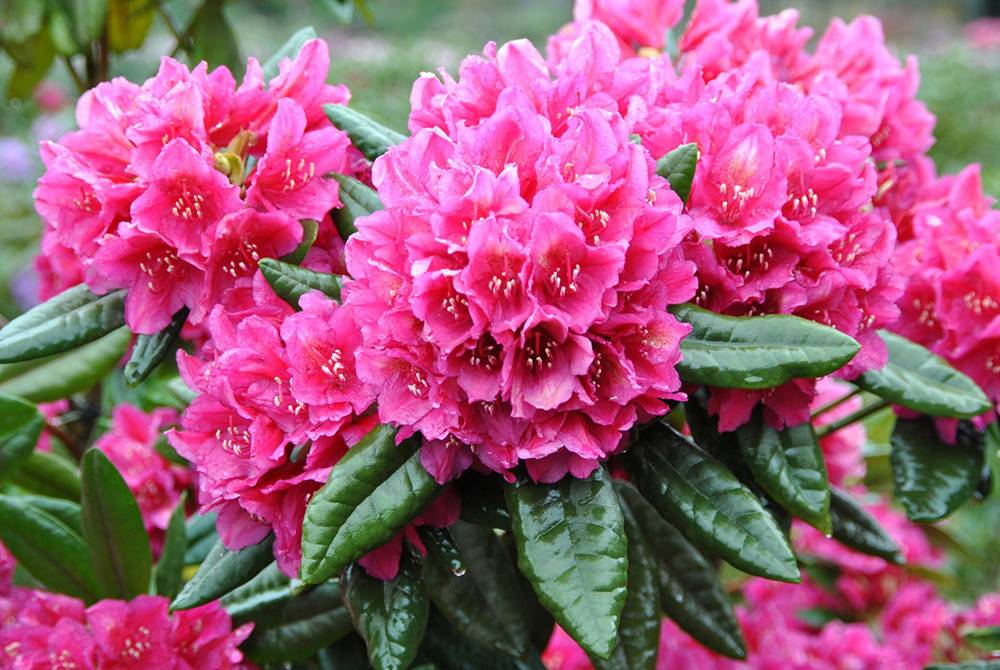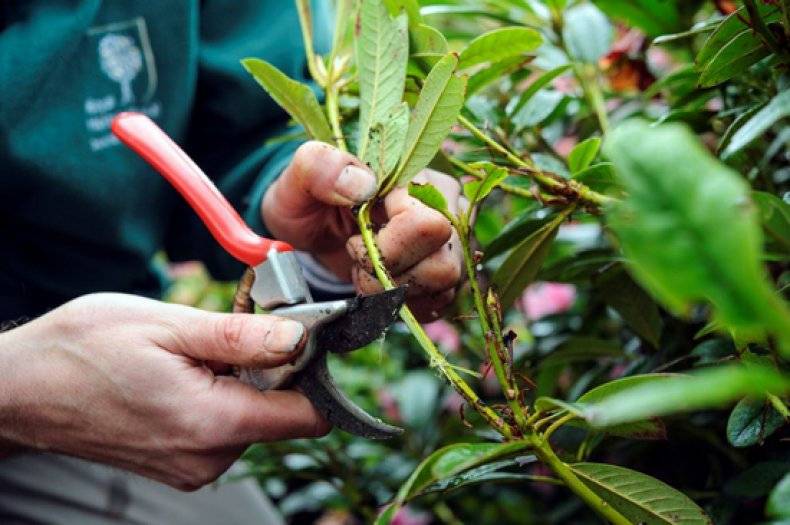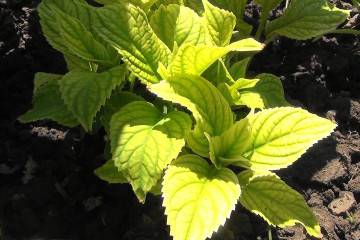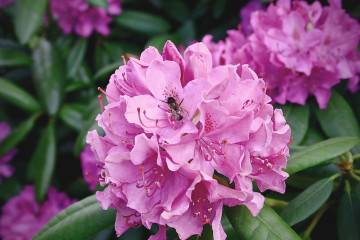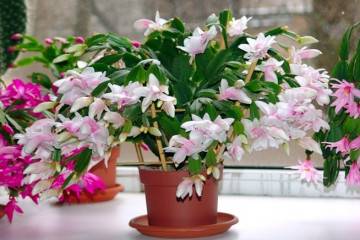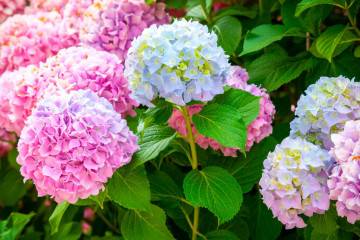Rhododendron diseases: why the leaves turned brown
Content:
Rhododendrons are shrubs or tree-like plants that have proven to be good medicines in traditional medicine. They grow mainly in the Northern Hemisphere and have hundreds of various species. The use of this plant is beneficial for cardiovascular diseases. It also has an anti-inflammatory, diuretic and tonic effect.
The flower has not only useful but also aesthetic properties. Rhododendron flowers resemble roses, and their color and size varies greatly from species to species.
Like other flowers, rhododendrons are prone to a number of specific diseases that everyone who grows them needs to know about. The article will discuss the main types of these diseases and recommendations on how to cope with them.
Rot types affecting the plant
Often, this plant begins to rot. This is an external symptom of one of the possible diseases. Treatment methods directly depend on the type of rot.
Root rot
It is caused by the fungus Phytophtora cinnamoni Rands, which affects the root system and stem at the base. Outwardly, it manifests itself as follows: the leaves of the plant begin to wither and gradually die off, the buds and roots of the plant become brown. If you do not take action, they rot, which leads to the inevitable death of the plant.
The reason for the appearance of this fungus is the growth of rhododendrons on unsuitable soil, which is either too moist or not acidic enough. Plant infection occurs through the roots or mechanical damage to the plant itself.
To cope with root rot, it is necessary to correct the condition of the soil by adjusting its acidity and reducing watering. Plants that are already infected must be burned to prevent the spread of the infection. If the plant is not completely damaged, but only individual shoots, it is enough to get rid of them.
Gray rot
It is caused by the fungus Botrytis gray, which exists in the soil as mycelium. He is able to be under the influence of unfavorable conditions for a long time, but continues his life activity.
Botrytis gray can only infect dead plant cells, and then spread further. Brown or brown spots with a dry surface appear on the rhododendron. When asked why rhododendron has brown leaves, what to do, many reasons and answers can be found. One of which is the defeat of this fungus.
Affected leaves or other areas must be cut off, and if the disease progresses, the plant is watered or sprayed with a weak solution of foundationol.
Late blight rot
Formed when the fungus Phytophthora cinnamomi is present in the soil. It can be introduced when acquiring new plants, or develop in soil with stagnant moisture.
A sign of such rot is the gradual wilting of the leaves. This usually manifests itself on certain branches that have been infected. These branches begin to turn yellow one by one, then the roots and wood rot.
Rot of buds
This type of rot is spread by cicadas, carrying the fungus Sporocybe azaleae. It affects not all types of rhododendrons, but only some of them. In this case, the buds turn brown and rot.
To combat bud rot, preparations containing copper are used, which destroy this fungus.
The main diseases of rhododendron and methods of their treatment
In addition to various fungal diseases, rhododendrons can be exposed to other diseases that require treatment. Often they arise due to improper care or non-compliance with recommendations for plant maintenance.
So, the development of diseases is promoted by:
- lack of trace elements in the soil;
- too active solar influence;
- a sharp change in temperature, cold climate;
- pest attack.
Diseases of rhododendrons, like other plants and organisms, are divided into infectious and non-infectious. The first group is the most extensive and includes all lesions caused by harmful fungi and bacteria. Each of the types of these diseases has its own symptoms and requires individual consideration to study the problem. Infectious diseases are presented below.
Tracheomycotic wilting
The causative agent is parasites, as a result of the development of which the leaves of the rhododendron curl. The onset of the disease begins with rotting of the roots, then the vessels of the plant are affected, thereby stopping the movement of nutrients inside the flower. The curled leaves dry out and crumble, and the infection gradually spreads to the bark of the stem.
The plant can be saved with a foundation in the form of a weak solution, and if this method is ineffective, all that remains is to burn the plant.
Dying off of shoots
Another type of disease that can lead to the death of a bush in the absence of a qualified fight against it. Initially, young buds stop blooming on the rhododendron. This indicates the defeat of the shoots. Over time, the disease spreads to the stem.
In order to prevent the death of the plant, it is worth removing all affected branches, and for prevention, spray the plant with copper-containing substances.
Septoria spotting
It mainly affects the leaves, but can also spread to the stem. Leaves turn yellow, turn red, brown and fall off early. Why do the leaves turn brown in rhododendron? This is due to the rapid spread of bacteria infecting the flower. Infected leaves are removed, and the plant is treated with copper sulfate for prevention.
Leaf mosaic
The viruses of this disease are carried by aphids and other insects. Most often found on the Alpine rhododendron. As a result of infection, the structure of the leaf becomes thinner, it becomes a pale yellow color with swellings.
Rhododendron rust
It is quite common. If the question is about why the leaves of rhododendron turned brown, most likely we are talking about this particular disease. Leaves can turn brown either completely or only in spots.
For the fight, drugs containing copper are used.
Bacterial root cancer
The causative agent of bacterial root cancer is the bacillus Agrobacterium. The defeat, as in a number of other cases, starts from the roots. The disease is dangerous because it continues to develop in the soil even after the death of the plant.
In the absence of treatment or the wrong approach, the infected plant begins to grow very slowly, or does not grow at all. Leaf litter gradually begins, spherical growths form on the roots.
If the disease of the plant has an initial stage, its treatment is possible by treatment with Bordeaux mixture. If the painful condition is neglected, the plant must be destroyed.
In the group of infectious diseases, one can distinguish such a subspecies as fungal. Their causative agent is a harmful fungus of one kind or another. These include the following diseases.
Tracheomycosis
The disease caused by fungi of the subspecies Fusaria is very active. A gray bloom forms on the flower, and the leaves and stems die off quickly. In addition, the affected areas can go lower, the root and vascular system is affected.
Cercosporosis
Fungal disease. On the outside, the leaves of the plant are covered with dark spots, and on the inside - with a gray bloom. It is possible to remove the disease using a solution of foundation and ditan.
Swelling of leaves
It is caused by the parasitic fungus Exobasidium rhododendri Cramer. It manifests itself in the form of thickening of the leaves.
In addition, extensive brown and red spots appear on them, the leaf may turn red as a whole, and on their surface you can see a coating that resembles wax. In the process of damage, the plants lose their appearance, their leaves curl and swell.
In addition to various infectious and fungal diseases, non-infectious diseases can also occur on rhododendrons.
Chlorosis
It occurs if the soil in which the shrub grows is too acidic. In this case, the edge of the leaves becomes covered with yellow spots, it becomes very noticeable on the plant that it is sick. In addition to excess soil acid, chlorosis of rhododendrons can also cause a lack of certain nutrients.
For the treatment of this disease, magnesium sulfate and iron are used, diluted in small proportions in a liter of water (no more than 7%).
Nitrogen starvation
The name is self-explanatory. Nitrogen starvation manifests itself in the following symptoms: a decrease in leaf size, slow bud set, and a decrease in flowering volume.
To eliminate this symptomatology, you need to properly saturate the soil with nitrogenous fertilizers and essential minerals such as potassium, magnesium, calcium, and so on.
Winter drying
This problem makes itself felt after severe winter frosts. Under the influence of low temperature, a violation of the moisture exchange process can occur, that is, the plant dries up greatly. It may even begin to shed the leaves completely, but more often than not, they simply fold. It is possible to restore the flower with abundant watering, replenishing the volume of liquid.
Before the onset of winter, it is necessary to thoroughly water the plant, as well as apply the necessary fertilizing so that it does not suffer from a lack of nutrients and firmly endures climatic influences.
Sunburn
This disease, or rather the result of a negative effect on the flower, usually manifests itself with sharp fluctuations in temperature. So, if at night the rhododendrons are in a cold environment, and during the day the rays of the bright sun fall on them, burns are almost guaranteed. This is due to the fact that a large amount of water rapidly evaporates from the surface of the delicate leaves. Outwardly, burns look like dry brown spots that dry out a lot.
To avoid such burns, you should choose a place for rhododendrons in accordance with the requirements for caring for them. These plants must be planted in places with partial shade, or artificially made during sunny summer weather. The sunburn effect can affect not only the leaves, but also the flower buds.
Soaking rhododendrons
This disease usually overtakes those plants that are trying to grow in unsuitable soil for them. Most likely, the flowers can get sick due to the fact that the soil is too clayey and poorly ventilated. In this case, the leaves become gray. Despite the fact that the roots remain relatively intact, problems arise with the growth of new shoots.
Why do rhododendron leaves wither and what to do about it? To resolve this issue, it is recommended to transplant the plant into soil with good air exchange, and also avoid excessive watering.
In order to understand what disease the plant has undergone, you can use a photo guide, which allows you to compare the images with the situation that has arisen.
Pruning rhododendron
For perennial flowers, which include rhododendrons, pruning is a must. Even if the plant looks beautiful and lush in appearance, it still needs it. Even minor breaks in branches or frost-bitten areas of a flower can harm its general condition and appearance. In such places harmful microorganisms can appear, they also attract insects.
Rhododendron pruning is carried out in spring and autumn, each of these procedures has its own reasons and characteristics.
- In spring, rhododendrons are pruned in order to remove all damaged areas and prevent the development of diseases. All of these areas are trimmed down to where healthy plant tissue begins. You can also prune branches that spoil the plant's appearance and shape.
- Autumn pruning of rhododendron in another way is called rejuvenating. It involves cutting off the ends of old shoots, which in the future will lead to the appearance of young ones. As a result, the bushes manage to regain their appearance and have a beneficial effect on their flowering.
Thus, rhododendrons are delicate and rather whimsical plants. For their successful cultivation, you should strictly adhere to the recommendations of experienced florists. The plant is susceptible to a large number of fungal, infectious and non-infectious diseases. The owner of such plants should know all the necessary information about the diseases and treatment of rhododendrons and take good care of them.
